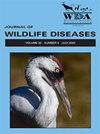英国斑海豹幼崽(Phoca vitulina)继发于寄生虫性穿孔性食管炎的脓胸。
IF 1.2
4区 农林科学
Q3 VETERINARY SCIENCES
引用次数: 0
摘要
一只搁浅的幼港海豹(Phoca vitulina)因急性呼吸困难而死亡。尸检发现食管穿孔是由第四阶段的隐性挛缩幼虫引起的,伴有脓胸和吸入性肺炎。脓胸在海豹中并不常见,而脓链球菌被认为是一种新的病因,继发于寄生虫性食管穿孔。本文章由计算机程序翻译,如有差异,请以英文原文为准。
Streptococcus phocae-Associated Pyothorax Secondary to Verminous Perforative Esophagitis in a Juvenile Harbor Seal (Phoca vitulina) in the UK.
A stranded juvenile harbor seal (Phoca vitulina) was necropsied following acute dyspnea and death. Necropsy revealed an esophageal perforation caused by fourth-stage Contracaecum osculatum larvae with Streptococcus phocae-associated pyothorax and aspiration pneumonia. Pyothorax is uncommon in seals, and S. phocae is considered a novel etiology, secondary to verminous esophageal perforation.
求助全文
通过发布文献求助,成功后即可免费获取论文全文。
去求助
来源期刊

Journal of Wildlife Diseases
农林科学-兽医学
CiteScore
2.70
自引率
0.00%
发文量
213
审稿时长
6-16 weeks
期刊介绍:
The JWD publishes reports of wildlife disease investigations, research papers, brief research notes, case and epizootic reports, review articles, and book reviews. The JWD publishes the results of original research and observations dealing with all aspects of infectious, parasitic, toxic, nutritional, physiologic, developmental and neoplastic diseases, environmental contamination, and other factors impinging on the health and survival of free-living or occasionally captive populations of wild animals, including fish, amphibians, reptiles, birds, and mammals. Papers on zoonoses involving wildlife and on chemical immobilization of wild animals are also published. Manuscripts dealing with surveys and case reports may be published in the Journal provided that they contain significant new information or have significance for better understanding health and disease in wild populations. Authors are encouraged to address the wildlife management implications of their studies, where appropriate.
 求助内容:
求助内容: 应助结果提醒方式:
应助结果提醒方式:


